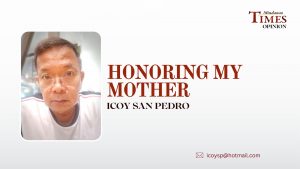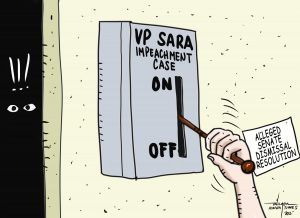By Patmei Bello Ruivivar
Many studies have shown that nutrition is the number one determinant of health. That has become an established fact, backed by significant evidence, that nobody is really challenging it anymore.
So now that we know that our health is significantly determined by the kind of food we eat, why is it difficult for us to make healthy food choices?
Because our current food system is designed to make us unhealthy.
This food system creates the food landscape — what, where, when, and how food is presented to us. It includes encounters with food at home, at school, at work, at grocery stores, at restaurants, and in the homes of our family and friends.
This food landscape is constantly manipulated through marketing gimmicks, advertisements, misleading food labels, discount prices, sales displays, and the like. But that landscape is just the tip of the ice cream, to use an edible metaphor. It is a result of a food system that is not designed to promote health.
I like the definition of a food system used by the International Fund for Agricultural Development (IFAD), an international financial institution and specialized United Nations (UN) agency that invests in rural people to promote food security, improve nutrition, increase income, and develop their resilience.
According to IFAD, a food system includes “all the aspects of feeding and nourishing people: growing, harvesting, packaging, processing, transporting, marketing and consuming food. It encompasses all the interactions between people and the natural world – land, water, the climate, etc. – and the natural world’s effects on human health and nutrition. It also includes the inputs, institutions, infrastructure and services that support the functioning of all these aspects, as well as the role of diets and cultural practices in shaping outcomes.”
A food system is healthy and sustainable when it provides sufficient nutritious food for all without compromising the health of the planet or the ability of future generations to meet their own food and nutritional needs.
Using that definition, it is food only when they are nutritious and promotes the health of humans and of the planet. So any talk of food security must mean everybody’s access to affordable healthy and nutritious food anytime, anywhere.
The COVID-19 pandemic exposed just how broken our food system is. Studies have shown the role of our food systems in the emergence of new infectious diseases. The loss of biodiversity due to unsustainable practices and the damage to ecosystems that it caused have contributed to chronic illnesses affecting humans.
Deaths from violence due to wars and crimes and those from natural disasters get more attention but we hardly talk about how our food system is killing people on a daily basis for many years.
Most of our food today is basically produced in industrialized factories and the value chain is controlled only by a few global corporations. Seeds are genetically engineered. Farm inputs used are made of toxic chemicals. Animal feeds are harmful to animals and to the humans who eat them. Since food are mass produced for mass consumption, more preservatives are used so the food can travel far and have longer expiration dates.
When our food is produced that way, how we consume it follows the same system. We buy them from stores and we need freezers to make them last longer. We microwave them so they are faster to prepare. And all those packaging go to the landfill or find their way to our rivers and lakes and oceans. Same thing happens when we eat in fast food restaurants.
I have read somewhere that an international agriculturist once said that the Philippines could produce enough food to feed the world. I have also thought about Mindanao being able to feed the whole Philippines. Yet here we are not being fed well enough or not at all.
Local farms planting endemic and native produce in the Philippines for centuries have been replaced by big corporations that will export and process the food we grow into preserved and canned versions of them that we buy in our grocery stores or online.
The vegetables planted around our Bahay Kubo now come in powdered form and are endorsed by our national celebrities. One advertisement even has the audacity to claim that the secret to having your children eat their vegetables is to sprinkle a magical powder made of artificial preservatives (probably to make them taste like the junk food they have been conditioned to eat).
Back in the day when the life described by our beloved Bahay Kubo song was how Filipinos lived, I imagine they did not complain about rising food prices. Because everyone grew their own food and food was prepared by people they knew. I imagine they also did not need “maintenance medicines” because they have their own “farm-acy” there in the backyard.
Now that the food system has changed, people who produce fresh, local, and organic food are perceived to be “crazy” and making things hard. People wonder why they go through all the trouble to grow their own food when you can just order from your phone.
There is also the perception now that eating fresh, local, and organic is more expensive (again, it’s the broken food system). Sure, cup noodles would cost less to eat daily now than an organic vegetable salad (but probably not if you grow the ingredients yourself). But the question we should probably ask ourselves is this: would you rather give your money to our organic farmers now or to the hospital for your dialysis or chemotherapy later?
While we are working to transform our current food system to bring small-scale organic farmers back at the heart of food production, let us support them by buying directly from local farms and farmers’ markets. Let us visit local farms and get to know the people who grow our food. Let us learn how they are produced and prepared and understand the relationship of the food we eat and the health of our bodies and our planet.
I think how life works is pretty simple enough that it’s taught in as early as grade school biology class. Everything is interrelated. That is why it is called a system.



